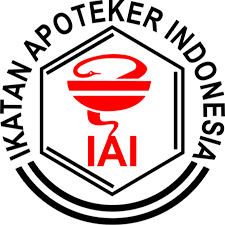Uji Aktivitas Hepatoprotektor Ekstrak Etanol Daun Rambutan (Nephelium lappaceum L.) pada Mencit Putih Jantan yang Diinduksi Parasetamol
Yuliawati Yuliawati(1*), Waode Cahaya Widya Putri(2), Havizur Rahman(3)(1) Jambi University
(2) Jambi University
(3) Jambi University
(*) Corresponding Author
Abstract
Hepatotoxicity is a drug complication that is often found in long-term drug use because of the role of the liver in metabolizing drugs. Paracetamol is an analgesic and antipyretic drug that is often used by the community and is a safe choice when taken according to the dose. However, if consumed in excess and in the long-term it causes hepatotoxicity (liver damage). Liver damage can be prevented by giving antioxidant compounds. Rambutan’s leaves contain secondary metabolites of alkaloids, tannins and saponins which are known to have antioxidant potential. The aim of the research is to determine the hepatoprotective activity and the effective dose of Rambutan leaves ethanol extract in male mice induced by patacetamol. The research method was The Randomize Posttest-only Control Group Design using 25 white mice which were divided into 5 groups. The results showed that there was a significant difference in the treatment group of rambutans leaf ethanol extract with the negative control group and a non-significant with the positive control group. Giving extract doses of 100 mg/kg BW, 200 mg/kg BW and 400 mg/kg BW because it prevents the increase in levels of SGPT, SGOT, relative liver weight and reduces the percentage of damage to the hepatocytes of mice. The effective dose of rambutan’s leaf ethanol extract as a hepatoprotector is 400 mg/kg BW.
Keywords
Full Text:
PDFReferences
Abdulkadir, W. S. and Tungadi, R. (2017) ‘The hepatoprotective effect of sea cucumber (Holothuria scabra) extract originating from gorontalo district using SGOT and SGPT parameters on mice induced by hepatotoxic dose Of paracetamol’, International Journal of ChemTech Research, 10(7), pp. 105–111.
Abidin, Z. Z. and Mardiyantoro, F. (2020) Diagnosis dan tata laksana perdarahan rongga mulut. Malang: Universitas Brawijaya Press.
Alamsyah et al. (2021) ‘Pengaruh ekstrak propolis (metode CMCE) terhadap kadar malondialdehid (MDA) dan degenerasi tubulus renalis’, Jurnal Litbang Edusaintech, 2(1), pp. 1–7.
BPOM RI (2014) Peraturan Kepala Badan Pengawas Obat Dan Makanan Republik Indonesia Nomor 7 Tahun 2014, Tentang Pedoman Uji Toksisitas Nonklinik Secara in Vivo.
Dart, R. C. (2004) Medical toxicology. 3rd edn. Philadelphia: Lippincott Williams and Wilkins.
Dewi, U. K. and Saraswati, T. R. (2009) ‘Efek rebusan daun tapak dara pada dosis dan frekuensi yang berbeda terhadap kerusakan dan akumulasi glikogen pada hepar mencit (Mus musculus)’, BIOMA, 11(1), pp. 1–5.
Gu¨lc¸in, I. et al. (2010) ‘Radical scavenging and antioxidant activity of tannic acid’, Arabian Journal of Chemistry, 3(1).
Gunawan, G. S. (2016) Farmakologi dan Terapi Edisi 6. Jakarta: Universitas Indonesia Press.
Gusungi, D. E., Maarisit, W. and Potalangi, N. O. (2020) ‘Studi aktivitas antioksidan dan antikanker payudara (MCF-7) ekstrak etanol daun benalu angsat Dendrophthoe pentandra’, Jurnal Biofarmasetikal Tropis, 3(1), pp. 166–174.
Hidayat, S. and Napitupulu, R. M. (2015) Kitab tumbuhan obat. Jakarta: Agriflo.
Indahsari, N. K. (2017) ‘Gambaran histopatologi hepar tikus putih (Rattus Novergicus) yang diinduksi dengan parasetamol dosis toksik pasca pemberian ekstrak etanol daun kelor (Moringa Oleifera)’, Jurnal Kimia Riset, 2(2), p. 123. doi: 10.20473/jkr.v2i2.6700.
Irmawarti, F. and Primiani, C. N. (2017) ‘Perbandingan uji toksisitas fitoestrogen pada ginjal tikus (sprangue dawley) yang diinduksi daidzein dan air perasan umbi bengkuang (Pachyrhizus erosus)’, Bioeksperimen, 3(2), pp. 52–60.
Jurnalis, Y. D., Sayoeti, Y. and Elfitrimelly (2014) ‘Peran antioksidan pada non alcoholic fatty liver disease (NAFLD)’, Jurnal Kesehatan Andalas, 3(1), pp. 15–20.
Meisyayati, S., Safitri and Hasanah, M. (2017) ‘Efek hepatoprotektor beberapa fraksi dari ekstrak daun sukun (Artocarpus altilis) terhadap mencit putih jantan galur swiss webster yang diinduksi parasetamol’, Scientia, 7(2).
Nazarudin, Z., Muhimmah, I. and Fidianingsih, I. (2017) ‘Segmentasi citra untuk menentukan skor kerusakan hati secara histologi’, Seminar Nasional Informatika Medis (SNIMed) VIII, 15, pp. 15–21.
Neal, M. J. (2006) At a Glance Farmakologi Medis. Jakarta: Erlangga.
Pangaribuan, F. X. R., Sitorus, S. and Saleh, C. (2016) ‘Uji Fitokimia dan Aktivitas Antioksidan Ekstrak Daun rambutan (Nephelium lappaceum) Dengan Metode DPPH (1 , 1-diphenyl-2-picryhidrazyl)’, Jurnal Atomik, 01(2), pp. 81–85.
Robbins, S. L. and Kumar, V. (1992) Buku ajar patologi 1. Jakarta: EGC.
Sancher, R. A. and Mcpherson, R. A. (2004) Tinjauan klinis hasil pemeriksaan laboratorium. Jakarta: EGC.
Sudjono, T. A., Widiatmoko, Y. W. and Karuniawati, H. (2012) ‘Efek infusa bunga rosella (Hibiscus sabdariffa) pada serum glutamte piruvat transaminase tikus yang diinduksi parasetamol dosis toksik’, Pharmacon: Jurnal Farmasi Indonesia, 13(2), pp. 65–69.
Utomo, Y. et al. (2012) ‘Studi histologi hati mencit (Mus musculus L.) yang diinduksi pemanis buatan’, Jurnal MIPA, 35(2), pp. 122–129.
Article Metrics
Abstract view(s): 3230 time(s)PDF: 3234 time(s)
Refbacks
- There are currently no refbacks.








